Economics for Managers Report
VerifiedAdded on 2019/11/08
|7
|1449
|151
Report
AI Summary
This report examines the effects of the Reserve Bank of Australia's (RBA) interest rate decisions on the Australian economy. It focuses on how the RBA's lowering of interest rates to a record low of 1.5% in 2017, in response to a government budget deficit and investor reluctance, impacts business investment. The report details how lower interest rates encourage borrowing, increase spending and investment, and influence the aggregate demand curve, real GDP, and price levels. Using figures to illustrate the relationship between interest rates, business investment, and macroeconomic indicators, the report concludes that the RBA's policy of lowering interest rates positively impacts the Australian economy by stimulating investment, increasing aggregate demand, and raising real GDP, although it may also lead to inflation.
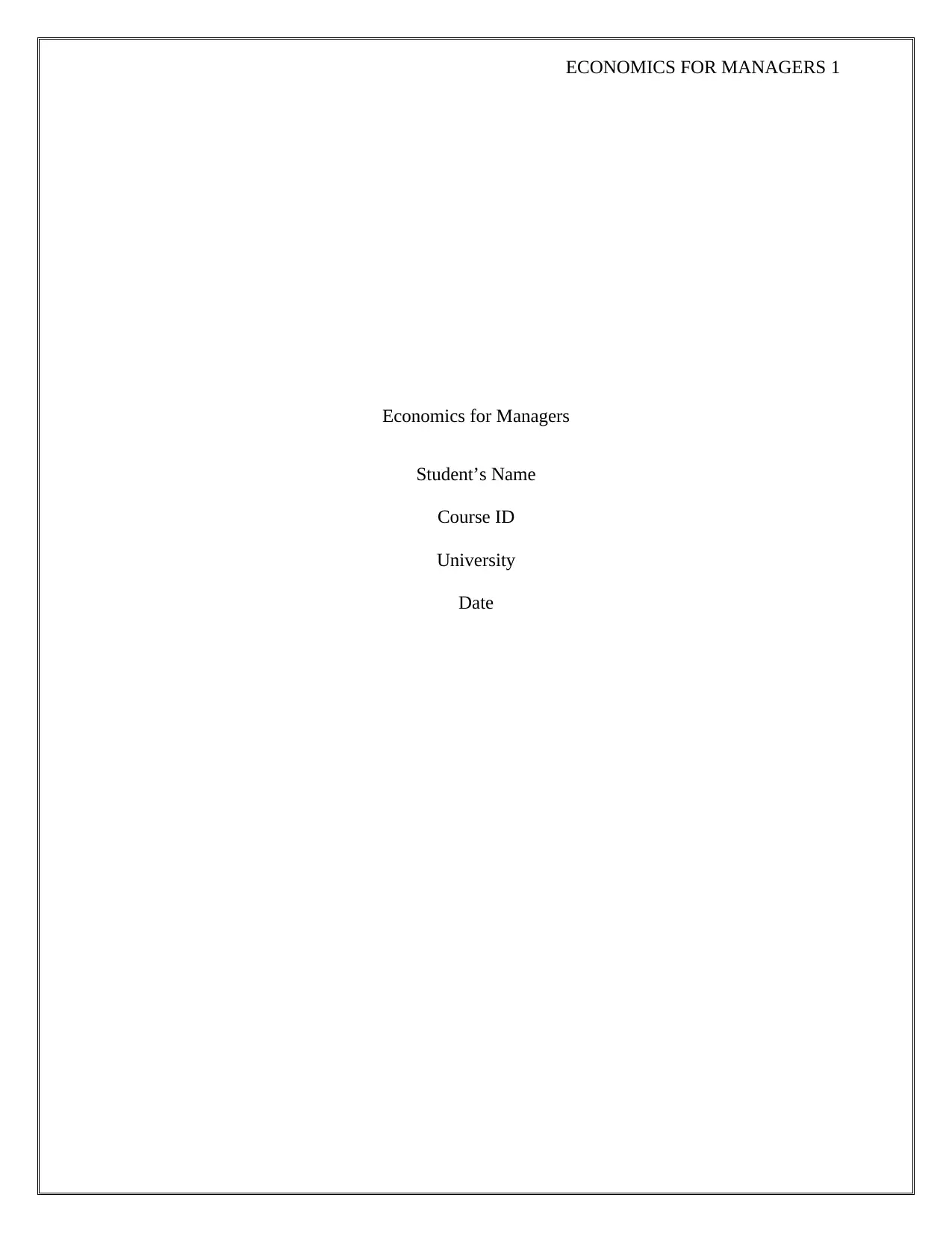
ECONOMICS FOR MANAGERS 1
Economics for Managers
Student’s Name
Course ID
University
Date
Economics for Managers
Student’s Name
Course ID
University
Date
Paraphrase This Document
Need a fresh take? Get an instant paraphrase of this document with our AI Paraphraser
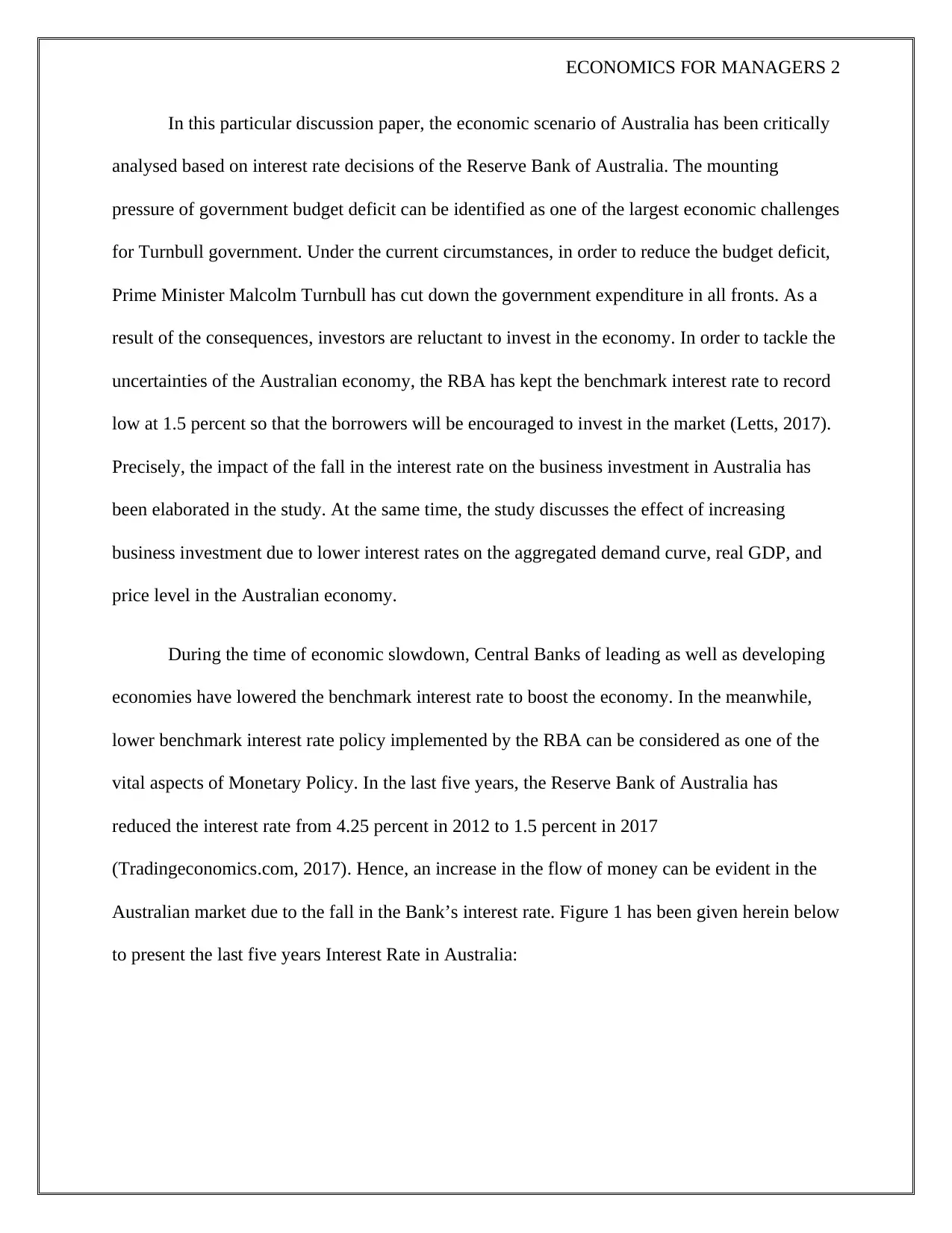
ECONOMICS FOR MANAGERS 2
In this particular discussion paper, the economic scenario of Australia has been critically
analysed based on interest rate decisions of the Reserve Bank of Australia. The mounting
pressure of government budget deficit can be identified as one of the largest economic challenges
for Turnbull government. Under the current circumstances, in order to reduce the budget deficit,
Prime Minister Malcolm Turnbull has cut down the government expenditure in all fronts. As a
result of the consequences, investors are reluctant to invest in the economy. In order to tackle the
uncertainties of the Australian economy, the RBA has kept the benchmark interest rate to record
low at 1.5 percent so that the borrowers will be encouraged to invest in the market (Letts, 2017).
Precisely, the impact of the fall in the interest rate on the business investment in Australia has
been elaborated in the study. At the same time, the study discusses the effect of increasing
business investment due to lower interest rates on the aggregated demand curve, real GDP, and
price level in the Australian economy.
During the time of economic slowdown, Central Banks of leading as well as developing
economies have lowered the benchmark interest rate to boost the economy. In the meanwhile,
lower benchmark interest rate policy implemented by the RBA can be considered as one of the
vital aspects of Monetary Policy. In the last five years, the Reserve Bank of Australia has
reduced the interest rate from 4.25 percent in 2012 to 1.5 percent in 2017
(Tradingeconomics.com, 2017). Hence, an increase in the flow of money can be evident in the
Australian market due to the fall in the Bank’s interest rate. Figure 1 has been given herein below
to present the last five years Interest Rate in Australia:
In this particular discussion paper, the economic scenario of Australia has been critically
analysed based on interest rate decisions of the Reserve Bank of Australia. The mounting
pressure of government budget deficit can be identified as one of the largest economic challenges
for Turnbull government. Under the current circumstances, in order to reduce the budget deficit,
Prime Minister Malcolm Turnbull has cut down the government expenditure in all fronts. As a
result of the consequences, investors are reluctant to invest in the economy. In order to tackle the
uncertainties of the Australian economy, the RBA has kept the benchmark interest rate to record
low at 1.5 percent so that the borrowers will be encouraged to invest in the market (Letts, 2017).
Precisely, the impact of the fall in the interest rate on the business investment in Australia has
been elaborated in the study. At the same time, the study discusses the effect of increasing
business investment due to lower interest rates on the aggregated demand curve, real GDP, and
price level in the Australian economy.
During the time of economic slowdown, Central Banks of leading as well as developing
economies have lowered the benchmark interest rate to boost the economy. In the meanwhile,
lower benchmark interest rate policy implemented by the RBA can be considered as one of the
vital aspects of Monetary Policy. In the last five years, the Reserve Bank of Australia has
reduced the interest rate from 4.25 percent in 2012 to 1.5 percent in 2017
(Tradingeconomics.com, 2017). Hence, an increase in the flow of money can be evident in the
Australian market due to the fall in the Bank’s interest rate. Figure 1 has been given herein below
to present the last five years Interest Rate in Australia:
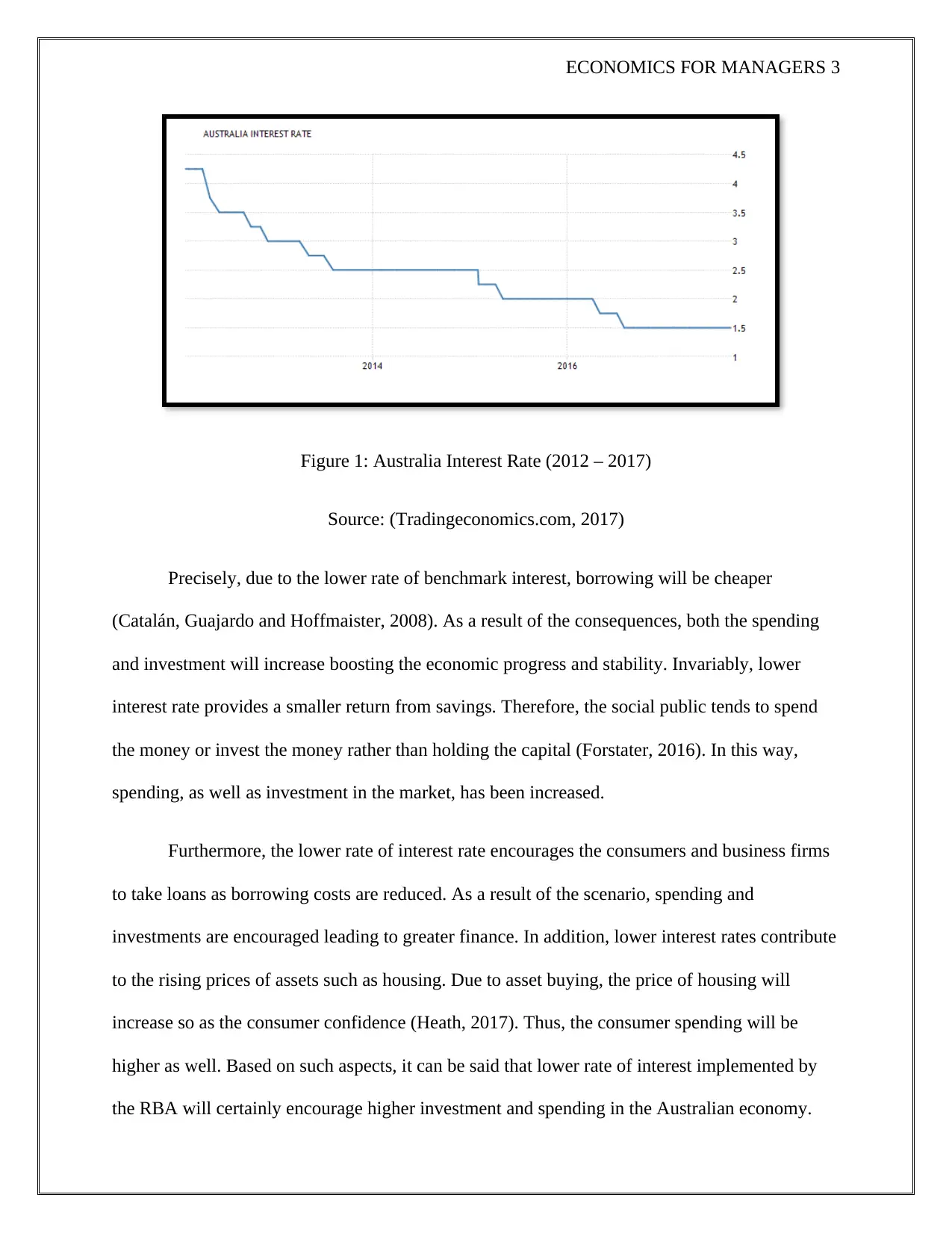
ECONOMICS FOR MANAGERS 3
Figure 1: Australia Interest Rate (2012 – 2017)
Source: (Tradingeconomics.com, 2017)
Precisely, due to the lower rate of benchmark interest, borrowing will be cheaper
(Catalán, Guajardo and Hoffmaister, 2008). As a result of the consequences, both the spending
and investment will increase boosting the economic progress and stability. Invariably, lower
interest rate provides a smaller return from savings. Therefore, the social public tends to spend
the money or invest the money rather than holding the capital (Forstater, 2016). In this way,
spending, as well as investment in the market, has been increased.
Furthermore, the lower rate of interest rate encourages the consumers and business firms
to take loans as borrowing costs are reduced. As a result of the scenario, spending and
investments are encouraged leading to greater finance. In addition, lower interest rates contribute
to the rising prices of assets such as housing. Due to asset buying, the price of housing will
increase so as the consumer confidence (Heath, 2017). Thus, the consumer spending will be
higher as well. Based on such aspects, it can be said that lower rate of interest implemented by
the RBA will certainly encourage higher investment and spending in the Australian economy.
Figure 1: Australia Interest Rate (2012 – 2017)
Source: (Tradingeconomics.com, 2017)
Precisely, due to the lower rate of benchmark interest, borrowing will be cheaper
(Catalán, Guajardo and Hoffmaister, 2008). As a result of the consequences, both the spending
and investment will increase boosting the economic progress and stability. Invariably, lower
interest rate provides a smaller return from savings. Therefore, the social public tends to spend
the money or invest the money rather than holding the capital (Forstater, 2016). In this way,
spending, as well as investment in the market, has been increased.
Furthermore, the lower rate of interest rate encourages the consumers and business firms
to take loans as borrowing costs are reduced. As a result of the scenario, spending and
investments are encouraged leading to greater finance. In addition, lower interest rates contribute
to the rising prices of assets such as housing. Due to asset buying, the price of housing will
increase so as the consumer confidence (Heath, 2017). Thus, the consumer spending will be
higher as well. Based on such aspects, it can be said that lower rate of interest implemented by
the RBA will certainly encourage higher investment and spending in the Australian economy.
⊘ This is a preview!⊘
Do you want full access?
Subscribe today to unlock all pages.

Trusted by 1+ million students worldwide
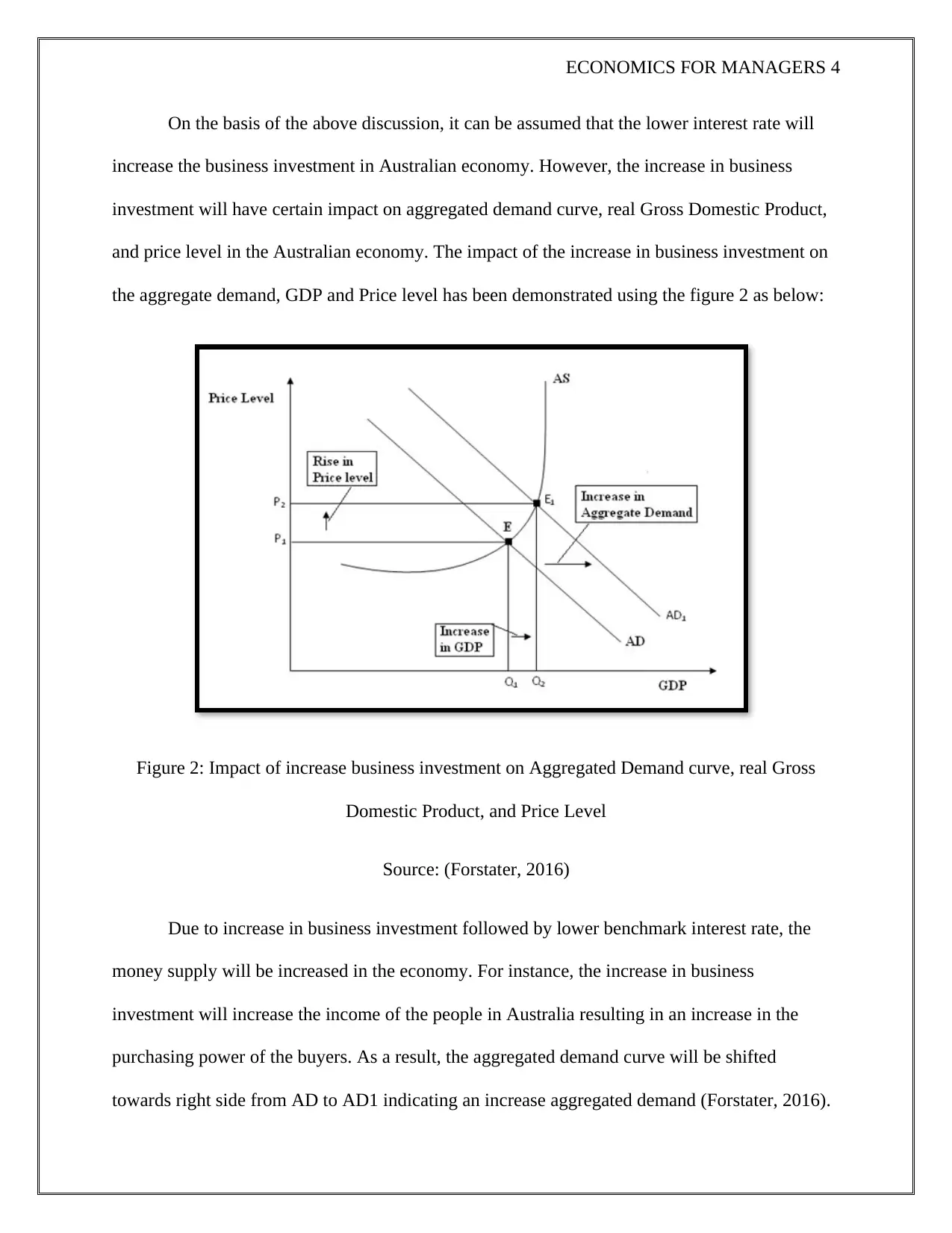
ECONOMICS FOR MANAGERS 4
On the basis of the above discussion, it can be assumed that the lower interest rate will
increase the business investment in Australian economy. However, the increase in business
investment will have certain impact on aggregated demand curve, real Gross Domestic Product,
and price level in the Australian economy. The impact of the increase in business investment on
the aggregate demand, GDP and Price level has been demonstrated using the figure 2 as below:
Figure 2: Impact of increase business investment on Aggregated Demand curve, real Gross
Domestic Product, and Price Level
Source: (Forstater, 2016)
Due to increase in business investment followed by lower benchmark interest rate, the
money supply will be increased in the economy. For instance, the increase in business
investment will increase the income of the people in Australia resulting in an increase in the
purchasing power of the buyers. As a result, the aggregated demand curve will be shifted
towards right side from AD to AD1 indicating an increase aggregated demand (Forstater, 2016).
On the basis of the above discussion, it can be assumed that the lower interest rate will
increase the business investment in Australian economy. However, the increase in business
investment will have certain impact on aggregated demand curve, real Gross Domestic Product,
and price level in the Australian economy. The impact of the increase in business investment on
the aggregate demand, GDP and Price level has been demonstrated using the figure 2 as below:
Figure 2: Impact of increase business investment on Aggregated Demand curve, real Gross
Domestic Product, and Price Level
Source: (Forstater, 2016)
Due to increase in business investment followed by lower benchmark interest rate, the
money supply will be increased in the economy. For instance, the increase in business
investment will increase the income of the people in Australia resulting in an increase in the
purchasing power of the buyers. As a result, the aggregated demand curve will be shifted
towards right side from AD to AD1 indicating an increase aggregated demand (Forstater, 2016).
Paraphrase This Document
Need a fresh take? Get an instant paraphrase of this document with our AI Paraphraser
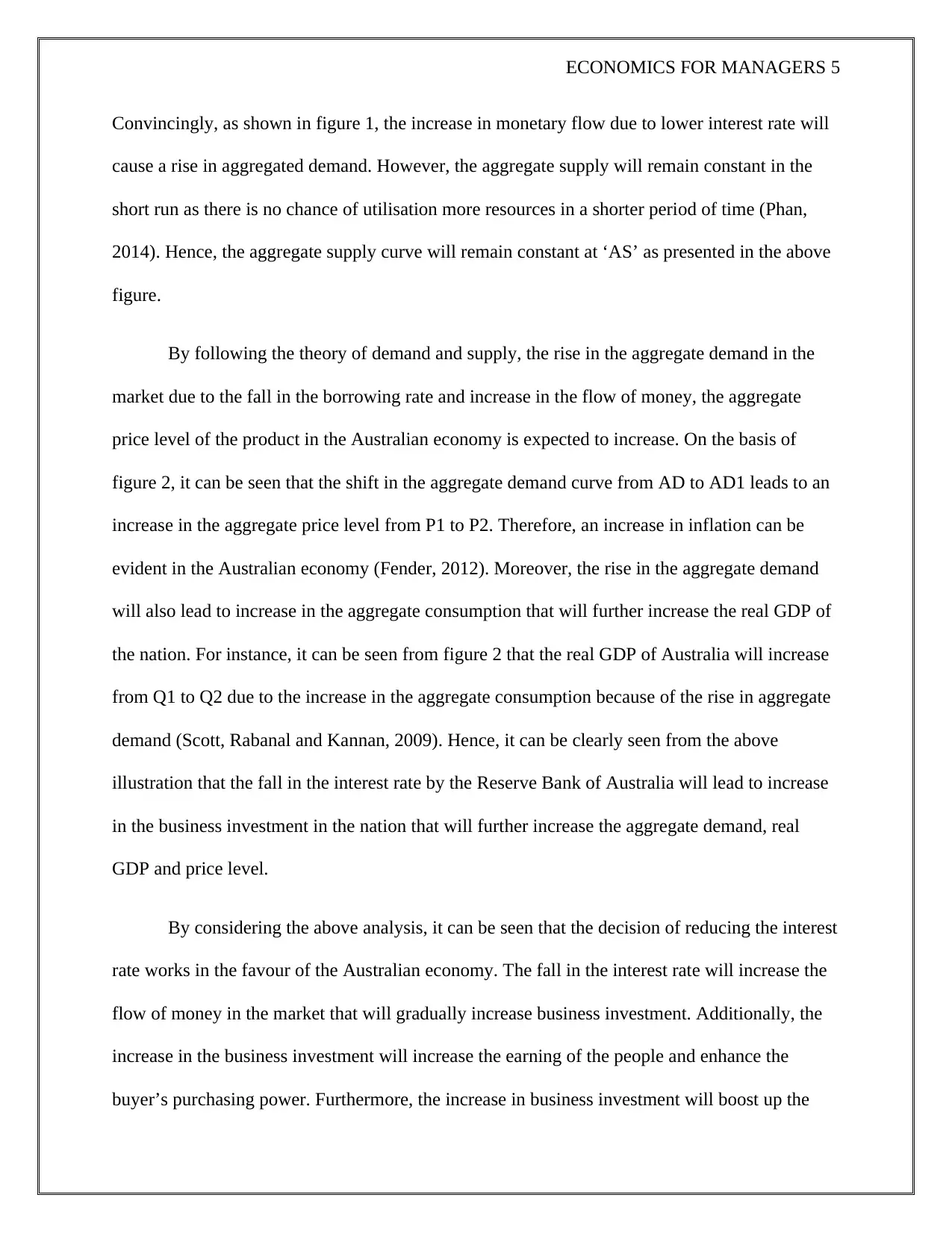
ECONOMICS FOR MANAGERS 5
Convincingly, as shown in figure 1, the increase in monetary flow due to lower interest rate will
cause a rise in aggregated demand. However, the aggregate supply will remain constant in the
short run as there is no chance of utilisation more resources in a shorter period of time (Phan,
2014). Hence, the aggregate supply curve will remain constant at ‘AS’ as presented in the above
figure.
By following the theory of demand and supply, the rise in the aggregate demand in the
market due to the fall in the borrowing rate and increase in the flow of money, the aggregate
price level of the product in the Australian economy is expected to increase. On the basis of
figure 2, it can be seen that the shift in the aggregate demand curve from AD to AD1 leads to an
increase in the aggregate price level from P1 to P2. Therefore, an increase in inflation can be
evident in the Australian economy (Fender, 2012). Moreover, the rise in the aggregate demand
will also lead to increase in the aggregate consumption that will further increase the real GDP of
the nation. For instance, it can be seen from figure 2 that the real GDP of Australia will increase
from Q1 to Q2 due to the increase in the aggregate consumption because of the rise in aggregate
demand (Scott, Rabanal and Kannan, 2009). Hence, it can be clearly seen from the above
illustration that the fall in the interest rate by the Reserve Bank of Australia will lead to increase
in the business investment in the nation that will further increase the aggregate demand, real
GDP and price level.
By considering the above analysis, it can be seen that the decision of reducing the interest
rate works in the favour of the Australian economy. The fall in the interest rate will increase the
flow of money in the market that will gradually increase business investment. Additionally, the
increase in the business investment will increase the earning of the people and enhance the
buyer’s purchasing power. Furthermore, the increase in business investment will boost up the
Convincingly, as shown in figure 1, the increase in monetary flow due to lower interest rate will
cause a rise in aggregated demand. However, the aggregate supply will remain constant in the
short run as there is no chance of utilisation more resources in a shorter period of time (Phan,
2014). Hence, the aggregate supply curve will remain constant at ‘AS’ as presented in the above
figure.
By following the theory of demand and supply, the rise in the aggregate demand in the
market due to the fall in the borrowing rate and increase in the flow of money, the aggregate
price level of the product in the Australian economy is expected to increase. On the basis of
figure 2, it can be seen that the shift in the aggregate demand curve from AD to AD1 leads to an
increase in the aggregate price level from P1 to P2. Therefore, an increase in inflation can be
evident in the Australian economy (Fender, 2012). Moreover, the rise in the aggregate demand
will also lead to increase in the aggregate consumption that will further increase the real GDP of
the nation. For instance, it can be seen from figure 2 that the real GDP of Australia will increase
from Q1 to Q2 due to the increase in the aggregate consumption because of the rise in aggregate
demand (Scott, Rabanal and Kannan, 2009). Hence, it can be clearly seen from the above
illustration that the fall in the interest rate by the Reserve Bank of Australia will lead to increase
in the business investment in the nation that will further increase the aggregate demand, real
GDP and price level.
By considering the above analysis, it can be seen that the decision of reducing the interest
rate works in the favour of the Australian economy. The fall in the interest rate will increase the
flow of money in the market that will gradually increase business investment. Additionally, the
increase in the business investment will increase the earning of the people and enhance the
buyer’s purchasing power. Furthermore, the increase in business investment will boost up the
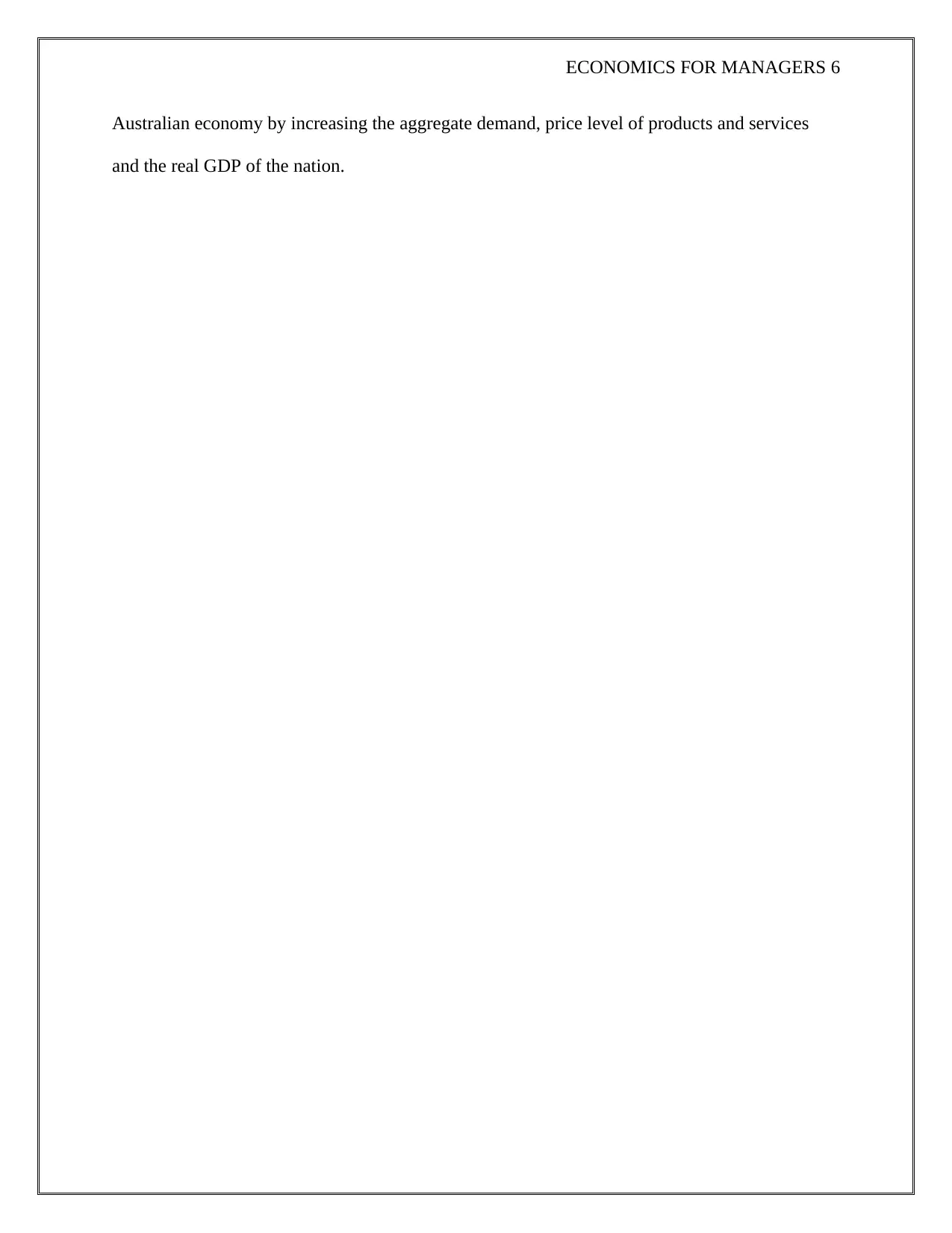
ECONOMICS FOR MANAGERS 6
Australian economy by increasing the aggregate demand, price level of products and services
and the real GDP of the nation.
Australian economy by increasing the aggregate demand, price level of products and services
and the real GDP of the nation.
⊘ This is a preview!⊘
Do you want full access?
Subscribe today to unlock all pages.

Trusted by 1+ million students worldwide
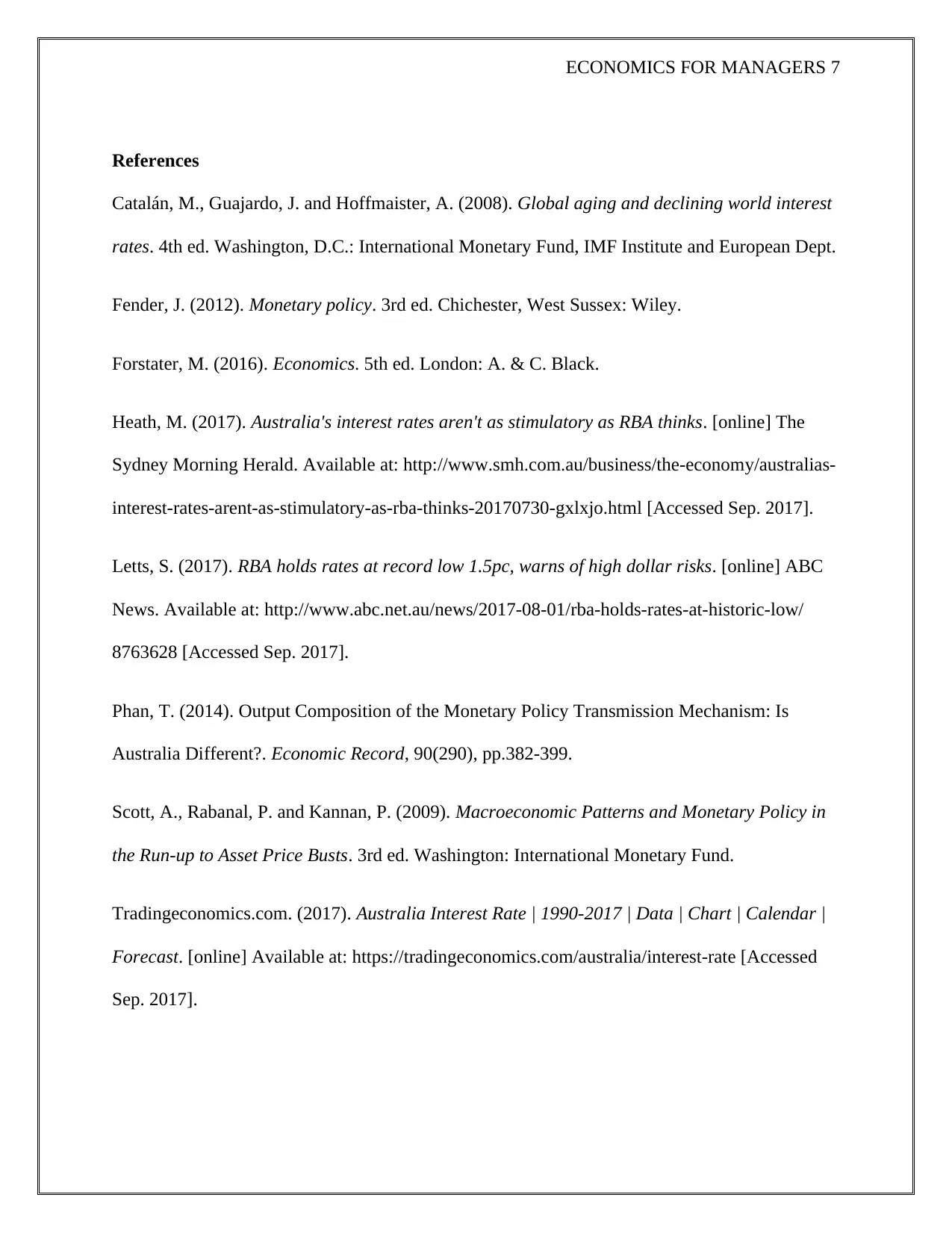
ECONOMICS FOR MANAGERS 7
References
Catalán, M., Guajardo, J. and Hoffmaister, A. (2008). Global aging and declining world interest
rates. 4th ed. Washington, D.C.: International Monetary Fund, IMF Institute and European Dept.
Fender, J. (2012). Monetary policy. 3rd ed. Chichester, West Sussex: Wiley.
Forstater, M. (2016). Economics. 5th ed. London: A. & C. Black.
Heath, M. (2017). Australia's interest rates aren't as stimulatory as RBA thinks. [online] The
Sydney Morning Herald. Available at: http://www.smh.com.au/business/the-economy/australias-
interest-rates-arent-as-stimulatory-as-rba-thinks-20170730-gxlxjo.html [Accessed Sep. 2017].
Letts, S. (2017). RBA holds rates at record low 1.5pc, warns of high dollar risks. [online] ABC
News. Available at: http://www.abc.net.au/news/2017-08-01/rba-holds-rates-at-historic-low/
8763628 [Accessed Sep. 2017].
Phan, T. (2014). Output Composition of the Monetary Policy Transmission Mechanism: Is
Australia Different?. Economic Record, 90(290), pp.382-399.
Scott, A., Rabanal, P. and Kannan, P. (2009). Macroeconomic Patterns and Monetary Policy in
the Run-up to Asset Price Busts. 3rd ed. Washington: International Monetary Fund.
Tradingeconomics.com. (2017). Australia Interest Rate | 1990-2017 | Data | Chart | Calendar |
Forecast. [online] Available at: https://tradingeconomics.com/australia/interest-rate [Accessed
Sep. 2017].
References
Catalán, M., Guajardo, J. and Hoffmaister, A. (2008). Global aging and declining world interest
rates. 4th ed. Washington, D.C.: International Monetary Fund, IMF Institute and European Dept.
Fender, J. (2012). Monetary policy. 3rd ed. Chichester, West Sussex: Wiley.
Forstater, M. (2016). Economics. 5th ed. London: A. & C. Black.
Heath, M. (2017). Australia's interest rates aren't as stimulatory as RBA thinks. [online] The
Sydney Morning Herald. Available at: http://www.smh.com.au/business/the-economy/australias-
interest-rates-arent-as-stimulatory-as-rba-thinks-20170730-gxlxjo.html [Accessed Sep. 2017].
Letts, S. (2017). RBA holds rates at record low 1.5pc, warns of high dollar risks. [online] ABC
News. Available at: http://www.abc.net.au/news/2017-08-01/rba-holds-rates-at-historic-low/
8763628 [Accessed Sep. 2017].
Phan, T. (2014). Output Composition of the Monetary Policy Transmission Mechanism: Is
Australia Different?. Economic Record, 90(290), pp.382-399.
Scott, A., Rabanal, P. and Kannan, P. (2009). Macroeconomic Patterns and Monetary Policy in
the Run-up to Asset Price Busts. 3rd ed. Washington: International Monetary Fund.
Tradingeconomics.com. (2017). Australia Interest Rate | 1990-2017 | Data | Chart | Calendar |
Forecast. [online] Available at: https://tradingeconomics.com/australia/interest-rate [Accessed
Sep. 2017].
1 out of 7
Related Documents
Your All-in-One AI-Powered Toolkit for Academic Success.
+13062052269
info@desklib.com
Available 24*7 on WhatsApp / Email
![[object Object]](/_next/static/media/star-bottom.7253800d.svg)
Unlock your academic potential
Copyright © 2020–2025 A2Z Services. All Rights Reserved. Developed and managed by ZUCOL.





